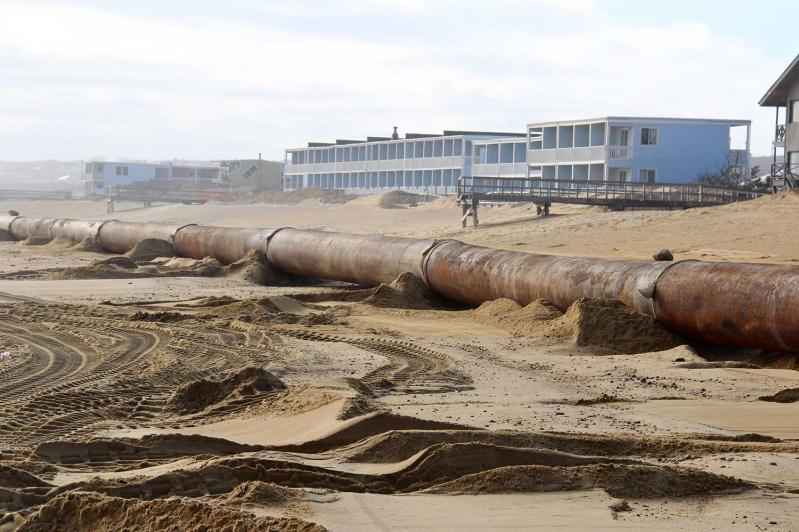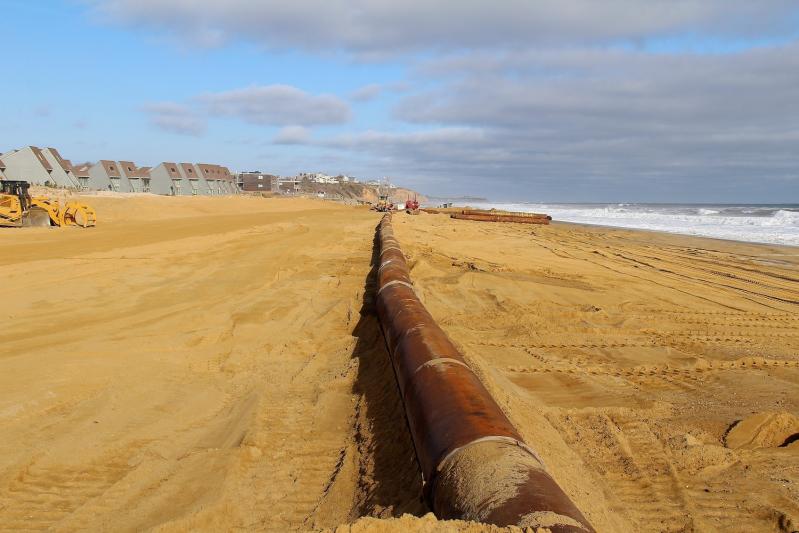More than 60 years in the making, the Fire Island to Montauk Point beach reformulation project will have arrived and departed from Montauk’s downtown in barely the blink of an eye. The beach-infill component of the project known as FIMP began on Feb. 6 and was completed on Sunday, with around 475,000 cubic yards of sand pumped from an offshore site by a 480-foot suction-hopper dredge called the Ellis Island.
On a site visit last Thursday, the infill component had neared its eastern terminus. The plan had initially called for 450,000 cubic yards, but as the clock struck midnight on Feb. 21, around 400,000 cubic yards had already been deposited on the beach, with four days to go, said Dan Kramer, a quality-control manager with Great Lakes Dredge and Dock of Houston, the contractor hired by the United States Army Corps of Engineers.
With a ferocious wind and waves relentlessly pounding the beach, several bulldozers pushed sand on either side of a 30-inch-diameter pipe bisecting it, through which slurry was pumped from offshore.
“They’re working well and fast,” Andy Harris, vice president of Concerned Citizens of Montauk, told The Star, “and I’ve been surprised how quickly they’ve gotten it done.”
Apart from minor delays due to rough weather, the project proceeded smoothly, Mr. Kramer said, though “smooth” does not fully apply to the material being deposited on the beach, which he described as “exceedingly coarse. A lot of rock.”
“That’s been a bit of a challenge,” he said. “The nature of the dredge, the vessel is such that all the material is screened in several steps, so . . . as bad as it is out there” — the offshore site from which the sand is being taken — “you’re not seeing anything like that on the beach.”
Many onlookers have observed that the beach is wider than they have seen it since the 1970s, and a survey of business interests revealed widespread gratitude and relief that the long-awaited project has finally been implemented. Perhaps not a moment too soon: Storms in December and January ravaged the beach, with the ocean lapping at dunes and damaging decks and pedestrian crossovers at the foot of “Motel Row” on South Emerson Avenue.
“Those hotels were built when the beach was a whole heck of a lot bigger than it is now,” Paul Monte, a past president of the Montauk Chamber of Commerce, told The Star. “No one thought that would happen 40 to 50 years ago, when they were built.”
“From the look of it, it looks very natural, like what was there before,” said Leo Daunt, president of the Montauk Chamber of Commerce and owner of Daunt’s Albatross Motel. “On the chamber side of things, we’ll be advertising a bigger, better beach this summer.”

Unlike the Army Corps of Engineers’ controversial shoreline stabilization project of 2015, in which thousands of geotextile sandbags were installed at the downtown beach, earning it the nickname “Dirtbag Beach,” this beach nourishment project has been largely welcomed. “There’s been a surprising amount of solidarity for the project,” Mr. Daunt said. “It was clear that something needed to be done. It’s a sand-only beach nourishment, benefiting not only the businesses, but also the community. Sometimes people forget that business and the community are tied together. Locals who grew up here are now running businesses here.”
“Everybody that I’m aware of is supportive of it and thrilled to see it finally happening,” Mr. Harris of C.C.O.M. said.
“As a community, you want to be able to use your beach downtown,” Mr. Daunt said. “Property values are affected by that beach tremendously. The beach is interconnected to everything that Montauk is about.”
“This is one part of a complicated, integrated approach to climate change,” Mr. Harris said. “It began with Superstorm Sandy in 2012, then the Army Corps’s emergency stabilization project in 2015, the town’s [Coastal Assessment Resiliency Plan], and now FIMP. All three elements are important to consider in their entirety.”
Beach renourishment will continue on a four-year cycle for 30 years. “While it’s exciting right now,” Mr. Harris said, “it’s only a 30-year plan. It gives everybody an opportunity to make the next plan.” The Coastal Assessment Resiliency Plan, or CARP, calls for a long-term managed retreat from the shoreline, itself a controversial plan that has been received coolly by some business owners.
“After working for over 20 years alongside five town administrations, multiple congressional representatives, and our county executives and legislators, I am ecstatic to see that the FIMP project has become a reality,” Mr. Monte said. “We have fought long and hard to gather support and provide critical infrastructure information to ensure that the planning, approval, and funding for this immensely important project was completed.”




